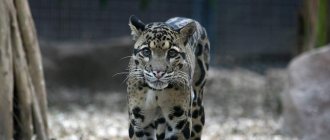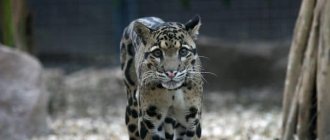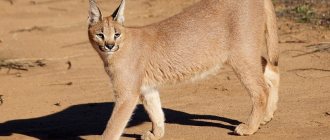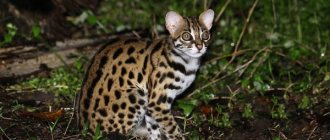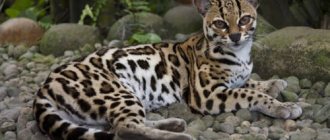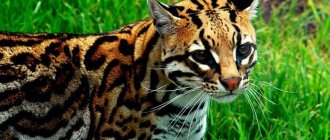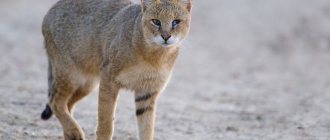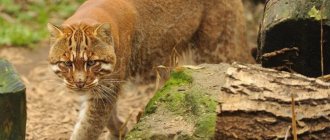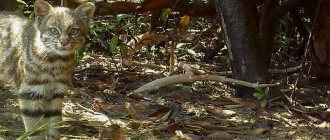The leopard is one of the most beautiful predators of the cat family (Felinae). Belongs to the genus “big cats” (Panthera), which is why leopards are often called panthers. Leopard is also known as leopard - they are the same animal, but the names have different origins. The name leopard is of Greek origin. The ancient Greeks considered these animals to be a mixture of a lion and a panther. The word leopard comes from the Turkic language. Both names have survived to this day and are used equally.
Appearance and color of the leopard
The mammal has thick fur with a bright color, the color is often yellow, but brownish and reddish shades are also found. Black, clearly defined spots scattered throughout the body (body, legs, tail). African leopards have smaller spots, while Asian leopards have larger spots.
The shade of yellow varies depending on the type of animal and its habitat. Central Asian mammals have a sandy-grayish color. Far Eastern animals have reddish-yellow fur, with thicker, fluffier fur that is slightly duller in color. Predators living in tropical forests and savannas, on the contrary, have bright, rich colored fur. There are also albino and flavist leopards - animals with faded gray and brown spots instead of the original black ones.
general description
Leopards are also called large cats. They are endowed with a very long and strong body, which is slightly narrowed at the sides. The head is small with a characteristic round shape. The ears are small and rounded. The average body size of leopards ranges from 90 to 190 centimeters in length with a tail ranging from 60 to 110 centimeters. The body weight of males ranges from 60 to 75 kilograms. The average weight of a female is almost two times less than the weight of a male.
The animals are remarkable for their characteristic color. Most subspecies do not change coat color depending on the time of year.
The main colors of leopards are yellow and red-yellow with small black spots.
Description, character and features of the leopard
Leopards hate water and rain. In rainy weather they hide and wait. Predators have excellent hearing and vision, but their sense of smell is rather weak. They have an excellent reaction - in speed and swiftness, leopards are superior to tigers and lions, although they are inferior to them in size. They can make a wide range of sounds - purring, hissing, growling, coughing, hoarse screams.
The leopard is an excellent tree climber, so it often hides prey in branches and sleeps mainly in trees. Their spotted color helps them successfully hide in foliage and grass. Leopards are able to sneak up on prey at a very close distance even in short grass up to 30-40 cm high; they are a perfect predator, fast and silent.
Capable of dragging a carcass twice its own weight, and can drag it up a tree. Predators reach a maximum speed of up to 60 km/h and have a powerful jump - they can jump up to 3 meters in height and up to 6 meters in length. The animal's favorite method of hunting is to jump onto the back of the prey from an ambush from a height of 5-6 meters and grab the prey by the scruff of the neck.
Leopard feeding habits
The main favorite food of leopards is roe deer, deer, and antelope.
Predators watch their victims near bodies of water, then jump and cling to the neck, killing the prey. Then they hide the carcass high in the trees, lifting up even the bodies of animals three times larger than themselves. If there are not enough ungulates, then the leopard hunts hare, birds and even monkeys. Can feed on carrion. In general, the leopard’s diet helps cleanse the environment of weak animals, that is, it is a kind of natural selection. Leopards often steal each other's prey from trees, as it can remain there for 2 to 7 days, depending on how hungry the predator that caught it is.
Where do leopards live?
Leopards live over a vast territory - in Africa (except the Sahara), in central and southern Asia (Nepal, India, Bangladesh, Bhutan, Pakistan, Sri Lanka), as well as in northern India, southern China and the Korean Peninsula. In Russia, this predator can be found in the Caucasus and Primorye. Of the entire cat family, the leopard has the largest habitat.
The animal's natural habitat is dense tropical, subtropical and mixed forests, savannas and plains, mountain slopes, and thickets along river banks. Leopards live successfully both in warm tropical conditions and in northern deciduous and coniferous forests. They are practically not found in deserts and arid areas.
Predators usually live alone and have their own territory. The area of one's own territory depends on the biomass density, that is, on the amount of potential prey, and on the terrain. In arid regions with low biomass density, the size of an animal's own territory will be several times larger than in a forest or mountainous area. Predators with large territories often have cross-territories with their neighbors. Females often share their territory with their female offspring, but older males usually move away from their mother's territory.
Leopard: description
Leopards are fairly large representatives of the Panthera genus, although they are somewhat smaller compared to tigers and lions. Experts say that adult males are 30 percent larger than females.
Appearance, dimensions
Leopards have a fairly muscular, elongated, noticeably laterally compressed body, designed for fast running, as well as for securely holding prey. At the same time, it looks light, slender and very flexible, which is why leopards are considered very graceful animals. The length of the tail is more than half the size of the body. Despite the fact that leopards' limbs are somewhat short, they are muscular and quite strong. The limbs are armed with light-colored claws, with a strong curve, which allows these predators to climb trees. The head, in comparison with the body, is small but round, while the forehead area has a convexity, and the facial part is elongated, but moderately. The ears are set wide apart, small, round in shape. The eyes are also small but round. Vybrissas are distinguished by their elasticity, and they are colored black, white or a combination of similar shades. Their length is about 10 cm.
The size of the animal, as well as its weight, mainly depends on its habitat. Animals living within forest zones are somewhat smaller in size compared to individuals living in open areas. The maximum body length of individual individuals reaches about 1.9 meters, while the length of the tail can be more than 1 meter. Adult males can weigh up to 80 kg, while females weigh 10 kilograms less. The height of males at the withers reaches 0.8 meters, and females are 30 centimeters lower. These animals do not have pronounced signs of dimorphism; therefore, males and females are distinguished by body size and weight, as well as structural features of the skull.
The animal's fur is quite short and close to the body, while it remains uniform regardless of the time of year. The nature of the coat is quite coarse, but quite thick. Wool may differ depending on the time of year, depending on the species. The main color of the coat is also associated with the species. Species living within Central Asia are characterized mainly by a sandy-grayish color, while the Far Eastern subspecies have reddish-yellow shades. Juveniles have brighter and lighter coat colors.
The basic color may vary depending on the season, although slightly. In the back area, as well as on the sides of the animal, including on the hips and within the shoulder blades, spots in the form of rings can be seen. On the limbs, as well as on the stomach, there are many solid spots, while the upper and lower parts of the tail are distinguished by the presence of large ring spots or solid, but numerous small spots. It should be noted that the nature and degree of spotting is inherent in each individual individual.
Melanistic leopards, called “black panthers,” are found in Southeast Asia. The coat of these animals is not completely black, but this allows them to perfectly camouflage themselves in dense thickets of vegetation.
In leopards that live in forest areas and within mountain ranges, a recessive gene responsible for coat color is quite common.
Interesting to know! In one litter that is born, along with cubs of the classic color, there may be black cubs. As a rule, such offspring are more aggressive and have other behavioral characteristics.
On the Malacca Peninsula, almost 50 percent of the individuals are black. A pseudo (incomplete) color mechanism for leopards is not uncommon, since the dark spots present become larger as they grow older, turning into a solid color.
LEOPARD - INTERESTING FACTS / LEOPARD INTERESNYiE FAKTYi
Behavior and lifestyle
Leopards are characterized by the fact that they prefer to lead a solitary, secretive lifestyle. They are found not only in the wilderness of forests, but also in close proximity to human settlements. As a rule, males spend most of their lives alone, compared to females, who spend half their lives feeding and raising their offspring. Each individual has its own territory, while for males this territory reaches a maximum of 1200 square km, and females are content with an area within 300 square km. These territories may overlap.
Each individual animal marks its territory in different ways. They can peel off the bark of trees or leave characteristic marks on the surface of the ground. Leopards mark resting places or special shelters using urine and excrement. For the most part, leopards try to lead a sedentary lifestyle, but the youngest individuals, in search of individual territories, move considerable distances. Leopards, like many other animals, have their own paths along which they constantly move. The main trails are located along river beds, with animals crossing water barriers over fallen trees and other vegetation.
Important point! Leopards are excellent tree climbers, which helps them rest in the treetops and avoid other, larger predators.
These animals prefer to locate their lair on slopes, which provides them with an excellent overview of the surrounding areas. Mammals use empty caves as shelters, as well as the root system of large trees, scattered stones and windbreaks, as well as huge stone overhangs. The animal is distinguished by a calm and very graceful step, while leopards can accelerate to 60 km/h when pursuing their prey. In addition, these predators are capable of jumping up to 7 meters in length and up to 3 meters in height. Moreover, leopards are considered excellent swimmers, which allows them to easily overcome any water obstacles.
How long does a leopard live?
Living in the natural environment, leopards live on average about 10 years, but in captivity these animals can live 2 times longer.
Where does it live?
To date, experts have identified nine subspecies of leopards, depending on their habitat. African leopards live within the African continent, not only in humid jungles, but also in mountainous areas, savanna conditions, and semi-desert conditions. These predators are not found in large deserts and arid areas.
Indian leopards are found in the territories of Nepal, Bhutan, Bangladesh, Pakistan, southern China and northern India. Their natural habitats are considered to be tropical and deciduous forests, as well as in northern regions with a predominance of coniferous trees. Ceylon leopards are found exclusively on the island territories of Sri Lanka. The North China subspecies inhabits the northern regions of China.
The Far Eastern or Amur leopard is common in Russia, China and the Korean Peninsula. Populations of the endangered Western Asian subspecies are associated with the territories of the Arabian Peninsula.
What does it eat?
Leopards, like all representatives of the Panther genus, are typical predatory animals, with the basis of their diet being ungulates, represented by antelopes, roe deer and deer. In the absence of the main components of their diet, these predators easily switch to feeding on rodents, birds, monkeys and reptiles. There are years when leopards attack domestic animals.
Important point! Leopards rarely attack people unless a person provokes an attack. Most often, wounded animals attack inexperienced hunters.
This predator easily copes with wolves and foxes. Leopards often feed on carrion, and they can steal prey from other predators. They prefer to hunt alone, while they wait for their prey while in cover. Sometimes you can see a leopard trying to sneak up on a group of small ungulates.
LEOPARD IN ACTION! Leopard against crocodile, hyena, antelope...
Reproduction and offspring
A characteristic feature of the southern territories of their habitat is the fact that leopards breed year-round. For the subspecies living in the Far East, the breeding season begins in the last months of autumn or the first months of winter.
The breeding season of leopards is characterized by the beginning of numerous fights between mature individuals, accompanied by loud sounds.
Interesting moment! The offspring of leopards grow and develop somewhat faster compared to the offspring of tigers. Already at the age of 3 years, juveniles are not much different in size from adults. Around this period, males are ready to mate, while in females this period begins earlier.
Females carry their offspring for 3 months, after which one or two cubs are born. Sometimes three babies are born, although this happens quite rarely. The offspring are born blind and practically defenseless. As a nest, females look for secluded places located among crevices or in caves, as well as in holes or under the root system of large trees.
Natural enemies
Wolves, which always hunt as part of a pack, pose a great danger to leopards. Fights with bears, lions, tigers, and also hyenas were noted. And yet, the main enemy of leopards is man.
What do they eat?
The animal's diet is wide and depends on the region. The main food of the predator is herbivores, but the leopard can also hunt small predators, especially in the absence of other food.
The diet includes:
- antelope
- roe deer
- deer
- wild boars
- badgers
- hares
- raccoon dogs
- monkey
- wild pigs
- small rodents
- reptiles
- snakes (including pythons)
- fish
The preferred prey is animals weighing from 10 to 40 kg, but the leopard is capable of hunting larger animals with a maximum weight of up to 150 kg. When there is a lack of food, this predator attacks livestock (sheep, horses, poultry). It does not disdain carrion and steals prey from other animals. Healthy predators rarely attack humans, but old or sick individuals who can no longer hunt their usual prey often become cannibals.
Interesting Facts
- Leopards are considered iconic animals that received special fame among ancient peoples. In Asia, sanctuaries and shrines were built in their honor. Many African tribes considered leopards to be a sacred totem.
- Among leopards there are cannibals. As a rule, they are old and sick animals that are not able to hunt. In the 20s, a case called the “Rudaprayag cannibal” was recorded. In India, a leopard entered a village where it killed 125 people.
- The appearance of the leopard is similar to the Bengal cat. This type of cat is distinguished by its well-developed hunting instinct and formidable character.
Leopards are extremely interesting and mysterious representatives of the fauna, which have some interesting features in their history and way of life.
Reproduction and offspring
Leopards are solitary animals, and only meet each other for procreation. In South Africa, these mammals breed all year round; in central Africa, mating occurs more often during the rainy season; in the Far East, only in January. Females attract males by smell and voice. The mating ritual includes fights with loud growls between males, and the imaginary aggression of the female, she growls aggressively and even attacks the male when he tries to jump on her.
Females mate for the first time at the age of 2 years, males become sexually mature at 1.5 years. Pregnancy lasts 3 months, on average 1-2, less often 3, kittens are born. Litters of 5-6 kittens are extremely rare. The female has only 4 mammary glands, so in a large litter one of the kittens will be malnourished. The interval between pregnancies in females is on average 8-12 months.
Kittens are born blind, the body weight of newborns is only from 280 to 1000 grams. The eyes open on days 4-9, and by 2 months all teeth have erupted. Lactation lasts about 4 months, and lactating females can leave kittens without milk for up to 3 days. Kittens remain with their mother until they are 1-1.5 years old, after which older males go in search of their own territory, and young females usually remain with their mother.
Breeding period
It is common for southern representatives to reproduce throughout the year. The inhabitants of the Far East organize the mating season from late autumn to early winter. The mating season is characterized by long fights, which are accompanied by loud roars. The rest of the time the animals are very quiet and calm.
The incubation period lasts for 3 months. Childbirth occurs within 6 hours. From 1 to 3 cubs are born with a body weight of up to 700 grams and a length of up to 15 centimeters. Leopards are born completely blind and covered with thick, long, dark brown fur with spots. Babies develop hearing and vision at the age of one and a half weeks. If the mother senses a potential threat, she quickly hides her cubs away from danger. Already at the age of 6 weeks, leopards begin to leave the den.
Leopard cubs
At first, the mother feeds the offspring with semi-digested meat, and then begins to bring small birds and small mammals. The female cares for the offspring in a specially equipped den, which is located in caves, crevices or blind holes. It is noteworthy that small leopards meow like domestic cats.
The offspring spend time with their mother throughout the year. During this time, she teaches them hunting and survival skills in the wild. After leaving their mother, young leopards stay together for some time.
Animals become sexually mature at the age of two and a half years.
Types of leopards
- Central Asian or Caucasian leopard (Pantera pardus ciscaucasica). Lives in Armenia, Afghanistan and Iraq. Previously found in the Caucasus, Turkmenistan, Turkey, Uzbekistan, Tajikistan and Iran, but now its population and habitat have decreased significantly.
- Black leopard, or black panther. A type of leopard with a dark color - there are even darker spots on the dark fur; from a distance it seems completely black, but it is the same spotted leopard, but with a dark color. Found mainly in Java. Individuals with a dark color are born from ordinary animals with a yellow color; dark and yellow kittens can be born in the same litter.
- Far Eastern or Amur leopard (Pantera pardus orientalis). It is found in the Far East, mainly in Primorye on the border with China. The northernmost subspecies of leopard. There are only a few dozen individuals left in nature.
- The white or snow leopard is also known as the snow leopard (irbis). Due to its external similarity, it was long considered a leopard, but now the snow leopard is separated into a separate genus, Snow leopards (Uncia), while leopards belong to the genus Panthera (big cats). In appearance, the snow leopard resembles a leopard, but is smaller in size and more stocky. It is distinguished by very thick long hair (hair length up to 55 cm), short legs, small head, long body and tail. The color is smoky gray without any yellow impurities. Lives in the mountains of Central and South Asia. The only representative of the cat family that lives where there is constant snow. There are currently about 3,000 individuals left in the wild in the world.
- Clouded leopard (Neofelis nebulosa). Despite its name, the clouded leopard is not actually a leopard. This smaller member of the cat family is classified into a separate genus, Clouded Leopards, while true leopards belong to the genus Panthera (big cats). The clouded leopard is small in size - weight is about 20 kg, body length including tail is 1.6 - 1.9 meters. Outwardly, it vaguely resembles a leopard. Lives in Southeast Asia. It is also called the "spotted leopard", but this is not quite the correct name.
- Mountain leopard . Rare little known species. Lives in the Alps and mountains of Africa. Individuals are counted in units.
Black and white leopards
Sometimes there are black leopards, which are also called black panthers. Although their fur color is completely black, they also have spots that are lighter shades of black.
In addition to melanistic leopards, there are also representatives with incomplete melanism or abundism. The spots of this representative are very wide and can merge into one whole. Thus, the black color appears only in certain areas of the animal's fur.
In nature, there are also completely white leopards, which are also called albinos. They are endowed with blue eyes and white coat color, on which spots distinguishable by shade are slightly visible. They are found in southern China or India. Only a few such representatives have appeared in nature reserves around the world.
Natural enemies
In northern latitudes, wolves pose the greatest danger to leopards, because Unlike solitary animals, wolves hunt and attack in packs. There are also skirmishes for prey with competing predators - bears, tigers, lions and hyenas take at least 5-10% of the prey from leopards. Predators rarely fight among themselves, although disputes over territory between individuals do occur. Currently, the main threat to the species comes from humans. The number of individuals has decreased significantly in recent years due to hunters, poachers, a reduction in food supply and a narrowing of the natural habitat.
Leopard behavior
Leopards usually lead a solitary lifestyle, except during the mating season.
Like many other predators, they are nocturnal. During the day they climb trees, where they rest quietly, and at dusk they go out hunting. Leopards are good steeplejacks and can easily jump onto trees or rocks up to 5 meters high. Leopards are distinguished by acute vision and keen hearing. Even in pitch darkness they can navigate perfectly. And their ideal protective color helps predators camouflage. This is why even experienced hunters often miss leopards. Their location is usually revealed by a long tail, which they cannot tuck, and if the animal is excited, the tail moves, which also attracts attention.
Leopards are the main threat to monkeys. The latter, when they notice a predator, try to climb as high as possible into the trees and begin to scream loudly. Even large baboons avoid meeting a leopard.
These cats very rarely attack humans, only if they are injured or provoked.
Breed conservation and species status
Currently, the number of individuals around the world has decreased significantly; leopards are listed in the International Red Book. Some species are already on the verge of extinction, including leopards in Java, Ceylon, and South Arabia. The reasons for the decline in numbers are simple - a decrease in food supply and living space, as well as the popularity of the animal as a hunting trophy among hunters, and the active shooting of animals by poachers because of their beautiful skin. The only hope for preserving the species is nature reserves and national parks.
Black leopard (panther)
Well, who is not familiar with such a character as Bagheera - a delightful and deadly black cat who raised and looked after the human cub Mowgli? Thanks to Rudyard Kipling's brilliant work “The Jungle Book,” the panther became famous throughout the world, although the very name of the animal caused considerable confusion among ordinary people.
Delightfully handsome black leopard
After all, many were sure that panthers are a separate species of wild cats, but in fact they are the same leopards, only with a black color. True, the differences between ordinary and black leopards are not only in the color of their fur; panthers also have several features that deserve special attention.
The dark color of panthers' fur is due to a mutation in the cells that produce melanin, the hormone responsible for color. This happens at the genetic level, and often manifests itself in animals living in impenetrable forests, where there is almost no sunlight. The black color helps panthers better adapt to life in the jungle, making them invisible to prey.
Where do panthers live?
If ordinary leopards can live in savannas and semi-deserts, then panthers prefer to settle in shady forests, the dense thickets of which serve them as excellent shelter and ambush sites. Huge black cats are found on the African continent, mainly at the foot of the mountains and dense jungles of Kenya and Ethiopia. Black leopards are also widespread in Asia, inhabiting the tropical rainforests of India and Malaysia and the islands of Java.
Jaguar and leopard
The jaguar is the closest relative of the leopard from the entire family of big cats. The lion, tiger, jaguar and leopard all belong to the genus Panthera. Jaguar and leopard are very similar to each other, however, they are different animals. The jaguar has a similar coloration - yellow fur and black spots all over the body, but the jaguar is much larger and has a stockier build. The jaguar lives in South and Central America, the leopard lives in Africa and Asia.
Species of leopards
Depending on the region where they live, these predators are divided into several subspecies. In general, all leopards have almost similar external parameters and lifestyle, although they may differ in size, color and coat structure.
There are several varieties of these stunning predators
The main types of spotted predators:
- African leopard (includes the Barbary leopard subspecies). Their habitat extends throughout Africa, where they inhabit both desert regions and humid tropics.
- Indochinese leopard. Mainly lives in southeast Asia, also found in Burma, Thailand and Malaysia.
Recommended by topic
Fox Panda Lynx
- Javan leopard. This subspecies is found only on the Indonesian island of Java, and is classified as an endangered wild cat.
- Indian leopard. Inhabits deciduous and tropical forests of India, Pakistan, Bhutan, Bangladesh and Nepal.
- Ceylon leopard. It is the closest relative of the Indian one, but lives exclusively in Sri Lanka.
- North China leopard. Large predators living in forested and mountainous areas of northern China.
- Far Eastern leopard. The second name of these cats is the Amur leopard; at the moment, their natural region is limited to Russian Primorye, and they are listed in the Red Book.
- Persian leopard (includes a subspecies of the Central Asian leopard). One of the largest representatives of spotted cats. Distributed in Iran, Turkey, Afghanistan, Turkmenistan, Azerbaijan and the North Caucasus.
- South Arabian leopard. It lives on the Arabian Peninsula; due to its critically low population, it is protected by environmental organizations as a species in danger of extinction.
Cheetah and leopard - what's the difference?
Many people confuse the cheetah and the leopard. In fact, these are different animals.
- Biologically, they belong to different genera: the cheetah is separated into a separate genus of cheetahs, and the leopard belongs to the genus Panthera.
- Cheetahs are easy to distinguish externally - on their muzzle they have black stripes from the corners of the eyes to the mouth, a kind of black tear tracks.
- The cheetah runs much faster than the leopard, but cannot climb trees like the leopard.
- The cheetah has longer legs and a narrow body adapted for running.
- Cheetahs are excellent sprinters and catch up with their prey, while leopards, on the contrary, quietly sneak up and attack from ambush.
- Cheetahs have ruffled, protruding fur, while leopards have smooth fur.
- A leopard can hide its claws, but a cheetah cannot.
- Leopards have large and regular-shaped spots on their skin, while cheetahs have smaller spots and different shapes.
Enemies of the leopard in the wild
Naturally, none of the animals hunt spotted predators. But this does not mean that leopards do not have to fear enemies, because in the struggle for survival and food resources they have plenty of competitors.
Leopard escapes from enemies by jumping into trees
The most dangerous enemies of leopards are lions. These predators live and hunt in packs, and it costs them nothing to kill a spotted cat in order to profit from its prey. True, the meeting of these animals rarely ends in a skirmish, because the prudent leopard prefers to abandon its prey and hide in the nearest tree, rather than engage in open combat.
The lion is the main enemy of the African leopard
Hyenas and wolves cause a lot of trouble for leopards, as they mainly attack young and immature kittens. And while protecting her offspring, the spotted female often dies from mortal wounds received in battle.
It may seem incredible, but when hunting baboons, leopards sometimes become their prey. As a rule, these monkeys scatter at the sight of a huge cat, but in some cases they attack their main enemy as a whole flock. Moreover, baboons have surprisingly sharp fangs, with which they can inflict lacerated wounds on a predator, and if the leopard did not have time to escape, then it has little chance of surviving in such an unequal battle.
Hunting and food
The leopard, thanks to the soft pads on its paws, is able to sneak up on its prey so quietly that not a single branch will crunch or a single leaf will rustle. He usually hunts medium-sized animals. It overtakes them with a swift, powerful jump up to 6 meters long.
Knowing how much a leopard weighs, you can admire how quickly it climbs the branches of tall trees, where it often ambushes or simply rests. Jumping on the prey, the spotted cat strangles it. After eating, he hides the leftover food in trees.
The diet mainly consists of ungulates (even quite large ones). Also, if necessary (period of lack of food), the leopard can attack rodents, birds, reptiles and monkeys. Quite often, sheep, dogs, and horses become its victims. Attacks on foxes and wolves also occur. A spotted cat can also eat carrion, as well as steal other people's prey.
Leopard habitat
The leopard cat lives over a much larger territory than any other wild cat. The breadth of its habitat is due to the diversity of its diet. Preferred habitats are forests, mountains and savannas.
The geography of settlement is quite extensive. They also live in Russia, where the predator has chosen to live in the Far Eastern, Caucasian and Central Asian parts.
Etymology and names
In ancient times, there was an opinion that the leopard was nothing more than a hybrid of a panther and a lion. It was this assumption that resulted in the name of the animal, combining two Greek words: leōn (which means “lion”) and pardos (which means “panther”). Modern scientists attribute the appearance of the name Panthera pardus to its origin in Latin via the Greek pánthēr. They also believe that the modern name of the leopard comes from the word of Indo-Iranian origin “pandarab”. It means "pale yellow" and was later borrowed into Greek.
The origin of the species name "leopard" originates in the Khatti language (which is a possible ancestor of the Adyghe and Abkhaz languages). The word prassun has also been found in Russian literary language since the 16th century. Initially, the name referred directly to the Caucasian leopards - Panthera pardus. Among the rangers of the Caucasus Nature Reserve in the 19th century, the word “pantiere” was used, the origin of which is attributed to the era of noble hunts. Russian zoologists also used the word “leopard” back in the 18th and 19th centuries.
How do leopards hunt?
Leopards are night hunters. But sometimes they can hunt during the day, especially in cloudy weather. Leopards go for prey in the pre-sunset hours and hunt in the first half of the night. If the hunt was unsuccessful, they continue it in the early morning.
These predators are capable of attacking a wide variety of animals, acting cunningly and swiftly. They lie in wait for victims mainly on the ground, but at the same time, they climb trees very well, overtaking prey there too. The gait of these felines is silent. They try to watch for their prey on animal trails or at a watering hole, on a salt lick or even on a tree branch. Leopards quietly and deftly sneak up on the object of the hunt, approaching it within 2 meters, and make the decisive throw. The leopard does not like to chase its prey: it most often runs no more than 40-50 meters after an animal attacked from an ambush. Leopards kill small animals with a bite to the neck. Jumping onto the back of a large animal, they knock it down, fall with the full weight of their body, wrap their paws around the victim’s neck and bite its throat or back of the head.
Leopards usually hunt alone. The female can go hunting with adult children while the family has not yet broken up. As a rule, leopards kill one animal without touching or scaring the rest. If the leopard does not eat the killed victim immediately, then it can drag the remains of the meal up a tree to protect it from hyenas, jackals and other carrion eaters. But usually they carry the remains several hundred meters away and hide them in thickets of plants. These predators do not compete with other big cats for food, as they feed not only on large ungulates.
The leopard dragged its prey onto a tree branch. Photo credit: Raphael Melnick, CC BY-SA 2.0
Leopard is the most mysterious cat
Leopards are the most mysterious of all big cats. These animals are so careful and vigilant that even in nature reserves it is difficult to track their lifestyle.
Baby leopard plays in the zoo.
The fur color of these predators helps them hide in the foliage of trees and grass and makes leopards almost invisible. There are also black specimens.
Black leopard, panther
The black coloration of panthers is a manifestation of melanism caused by a gene mutation and is characteristic only of females, with rare exceptions. The fur of a black panther is not perfectly black; it always shows visible spots to a greater or lesser extent.
Extinct leopard subspecies
The European leopard (lat. Panthera pardus sickenbergi) lived in Europe. Extinct about 10,000 years ago, towards the end of the Pleistocene.
The Zanzibar leopard (lat. Panthera pardus adersi) is presumably an extinct subspecies. He lived on the island of Unguja (Zanzibar). The last time the Zanzibar leopard was observed in this area was in 1980.
Photo credit: Peter Maas, CC BY-SA 3.0
Leopard and man
Unfortunately, most people do not know what kindness and respect for wildlife means. Due to the fault of man, many species of animals are under threat of extinction, and some of them can only be found in the zoo or in pictures in school textbooks.
Such amazing animals as leopards have also come under the radar of ruthless poachers. They were once hunted for their prized spotted pelt, and such trophies are still in high demand on black markets. Many animals also die during an exotic safari - a popular entertainment among the rich and those who like to show off against the backdrop of a personally killed predator.
In China, leopards were practically exterminated, and not only because of their fur, but also because Chinese healers are confident that the internal organs of these cats have healing properties, and they prepare “medicinal decoctions” based on them.
In fairness, it is worth noting that there are people who resist illegal poaching with all their might. Many countries where leopards live have laws prohibiting the shooting of these cats.
Huge cats know how to be grateful
Volunteers also provide invaluable assistance in saving leopards. They nurse wounded animals and orphaned children, and then release them into the wild. And in national parks and reserves there are squads on duty, consisting of municipal and veterinary police, whose task is to find poachers and stop their criminal activities.
Leopard hunting
Leopards, like other predators, are useful in that they destroy sick animals and curb the growth of pest populations, such as monkeys.
People hunt the beautiful spotted cats for their valuable fur, and also destroy them due to predators attacking livestock. But, basically, leopard populations are decreasing due to human economic activities and, accordingly, changes in the leopards’ usual habitats. In some areas the leopard is on the verge of survival, and in others it has been completely destroyed. But, nevertheless, in most of its range the animal successfully survives thanks to its ability to successfully hunt and adapt to any living conditions. In some countries, leopards are also killed for fun.
This mammal is one of the so-called “big five” animals - favorite objects of sport hunting, among which are the lion, elephant, buffalo, rhinoceros and leopard. To achieve this, an international organization that monitors issues of trade in endangered wild species of animals and plants allocates quotas for the shooting of leopards. This does not reduce the population of these predators. States receiving these quotas care about the conservation of the species.
Leopard hybrids
Among leopards there are hybrids - such as leopon. Leopon is a hybrid resulting from crossing a male leopard with a female lion. The existence of Leopon was first officially confirmed in Kolhapur in India at the beginning of the 20th century. Later they began to be deliberately bred in zoos in Germany, Japan and Italy. Leopard hybrids cannot bear offspring. The appearance of the leopon is also quite interesting. Its head is shaped more like a lion's. All other parts of the hybrid's body are more similar to the body of a leopard. The size of the hybrids is usually somewhere between a lion and a leopard. Male hybrids sometimes have a mane similar to a lion's, which can reach 20 cm in length. The color of leopons is distinguished by brown or black spots, and their tail is decorated with a lion's tassel at the end.
Another leopard hybrid is the berry pard - it appeared after crossing a male jaguar and a female leopard.
Biology and ecology of leopards
Territorial and social behavior
The leopard is a solitary animal, leading a predominantly nocturnal lifestyle. These animals can easily adapt to any living conditions. They can live in forests and mountains, as well as in deserts. The areas of their individual habitat can vary from 8 to more than 400 km2 - it all depends on the terrain and the availability of food for the animal. The modest size of the leopard does not prevent it from successfully hunting large prey - their victims can sometimes weigh up to 900 kilograms.
Leopards have unique tree climbing skills. They can climb on them for the purpose of recreation or for the purpose of hunting monkeys. But more often, nevertheless, leopards engage in ground hunting. As a rule, the predator very quietly and carefully approaches its prey at a distance of one jump, and then pounces on its prey and strangles it. If the jump is unsuccessful, the animal does not pursue the victim. Sometimes a leopard can deliberately noisily approach its prey and then hide. In this case, the hunting victim was confused, not understanding from which side to expect an attack. Often, the leopard lifts the remains of its victims high into a tree in order to protect them from jackals and hyenas.
Leopard food
The leopard's diet usually consists of ungulates - antelope and deer, as well as roe deer. Sometimes the predator can feed on rodents and monkeys, as well as birds and snakes. May also attack sheep and horses. Domestic dogs, as well as wild foxes and wolves, often suffer from leopards. A leopard, due to lack of food, can steal prey from other leopards. As for people, leopards rarely attack them - to do this you need to disturb the animal. However, a leopard always attacks if it is wounded - in this case the consequences can be the most dire.
Hunting for prey
As a rule, leopards do not hunt collectively, preferring to hunt alone. The predator sneaks up on the prey or waits for it somewhere in ambush.
Leopard breeding
Leopards usually breed year-round in the southern regions of their range. Populations living in the Far East usually breed in late autumn or early winter. The breeding of leopards is usually accompanied by fights and roars from male leopards, which is typical for cats. The rest of the time, the leopard is very silent, which cannot be said about the lion or tiger. Pregnancy for a female leopard usually lasts three months. Its result is the birth of one or two (much less often three) blind leopard cubs. Leopards usually make their lair in caves or rock crevices. Holes formed by uprooted tree roots can also serve as shelter. Leopards choose a quiet and inconspicuous place. Leopard cubs mature ahead of tiger cubs - usually after 2.5 years they become sexually mature. What is noteworthy is that female leopards mature earlier than males.
Leopard (leopard) – description and photo. What does a leopard look like?
Leopard is one of the representatives of large cats. The body of the animal is elongated, flexible, slender and strong. The length of the body varies from 91 to 180-190 cm. The height at the shoulders is 45-80 cm. A leopard weighs from 15 to 75 kg (depending on the subspecies and sex of the animal), extremely rarely reaching 100 kg or more. Males are 1.5-2 times larger than females.
The leopard's head is round, relatively small, with a noticeably convex forehead, sloping crown and moderately blunt muzzle. The ears are short, triangular, rounded, without tufts. A leopard's eyes are small and the pupils are round. The animal has well-developed vision and hearing, but the sense of smell is weak. The predator's fangs are relatively thin at the base, but high and sharp. The tail is long - 75-110 cm and makes up at least 2/3 of the body.
Photo credit: Alfred Hutter
Photo credit: Chintu Rohith, CC BY-SA 4.0
The leopard's legs are slender, relatively low and very strong. There are soft pads on the paws.
The leopard's claws are hidden. He releases them only when it is time to grab prey or when he needs to climb a tree.
The leopard's fur is rough and short - about 25-30 mm on the back, shorter on the tail. The fur of leopards living in tropical countries is brightly colored, but not fluffy. In winter, Far Eastern leopards are fluffy and denser. The body, legs, head and tail of the animal are covered with clearly defined spots. They can be solid or in the form of rings. The spots are larger on the animal’s belly and paws, and smaller on the head. On the back they are collected into rosettes. The largest leopard spots do not exceed 5 cm in length. In some cases, in the rear region of the back or on the sides they merge into stripes, and on the tail they form transverse rings.
The spotted pattern stands out against the yellowish or reddish color of the leopard's coat, the shades of which depend on the mammal's habitat: from yellow-brown to light yellow.
Young individuals are somewhat lighter than older ones. Their general tone is grayish-yellow or off-white. Summer leopard fur is rarer, shorter and lighter than winter fur. By the way, leopards are characterized by different lengths of yellowish and black hair. The black hairs that make up the spots are longer and thinner than the yellow ones. The degree of spotting and the shape of the spots may vary. Black color may acquire a brownish tint.
Thanks to their coloring, leopards are well camouflaged, clinging to the ground or hiding in the branches of trees. It is difficult to see them in grass no more than 50 cm high, even if you are several tens of meters away from them.
By the way, to communicate with other individuals, leopards use visual communication, namely: white spots that are located on the ears and at the tip of the tail. For example, by exposing these spots, females convey a message to their cubs while hunting or while in tall grass.
Photo credit: Profberger, CC BY-SA 3.0
When communicating with their relatives, leopards make various sounds. This can be a growl or roar, snorting, rumbling, purring. The leopard's voice is so loud that it can be heard in the mountains several kilometers away. The growl of a leopard resembles the sound of a saw cutting into a tree. This is how the mother calls her cubs to her, and females call males during estrus. When establishing contact with other individuals and marking the boundaries of its territory, the leopard emits a creaking growl. The frequent cry of males during the rut is similar to a sharp cough that turns into sighs. But, in general, the leopard rarely makes sounds and is silent, even when caught in a trap.
Leopards are cautious and secretive animals, but at the same time very brave. They do not run away, but calmly retreat when meeting a person. Carrying away prey in front of people, predators do not pay attention to screams and even shots. Sport hunting for a leopard in permitted areas is considered one of the most dangerous, since a wounded animal, unlike many predators, rushes at the hunter.
Photo by: Milan Kořinek
